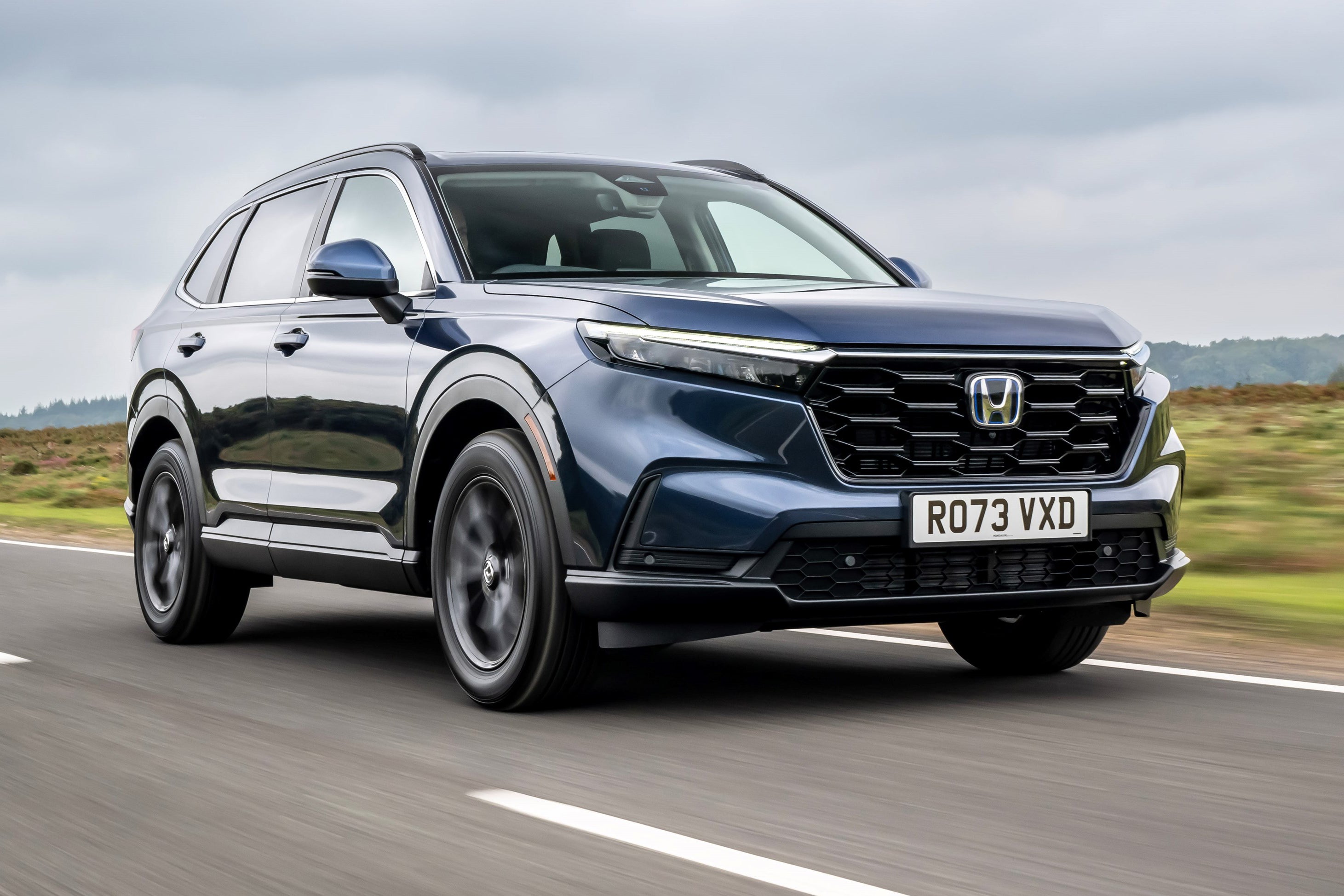Honda CR-V Review 2025: Price, specs & boot space
Written by Richard Aucock
Quick overview
Pros
- Good fuel economy as standard
- Spacious interior and boot capacity
- Long list of standard equipment
Cons
- List prices look expensive
- No seven-seat option available
- Engines are not particularly powerful
Verdict: Is the Honda CR-V a good car?
“The sixth-generation Honda CR-V delivers a well-rounded family SUV experience, with the choice of two efficient hybrid powertrains. It looks expensive against its closest rivals, though.”
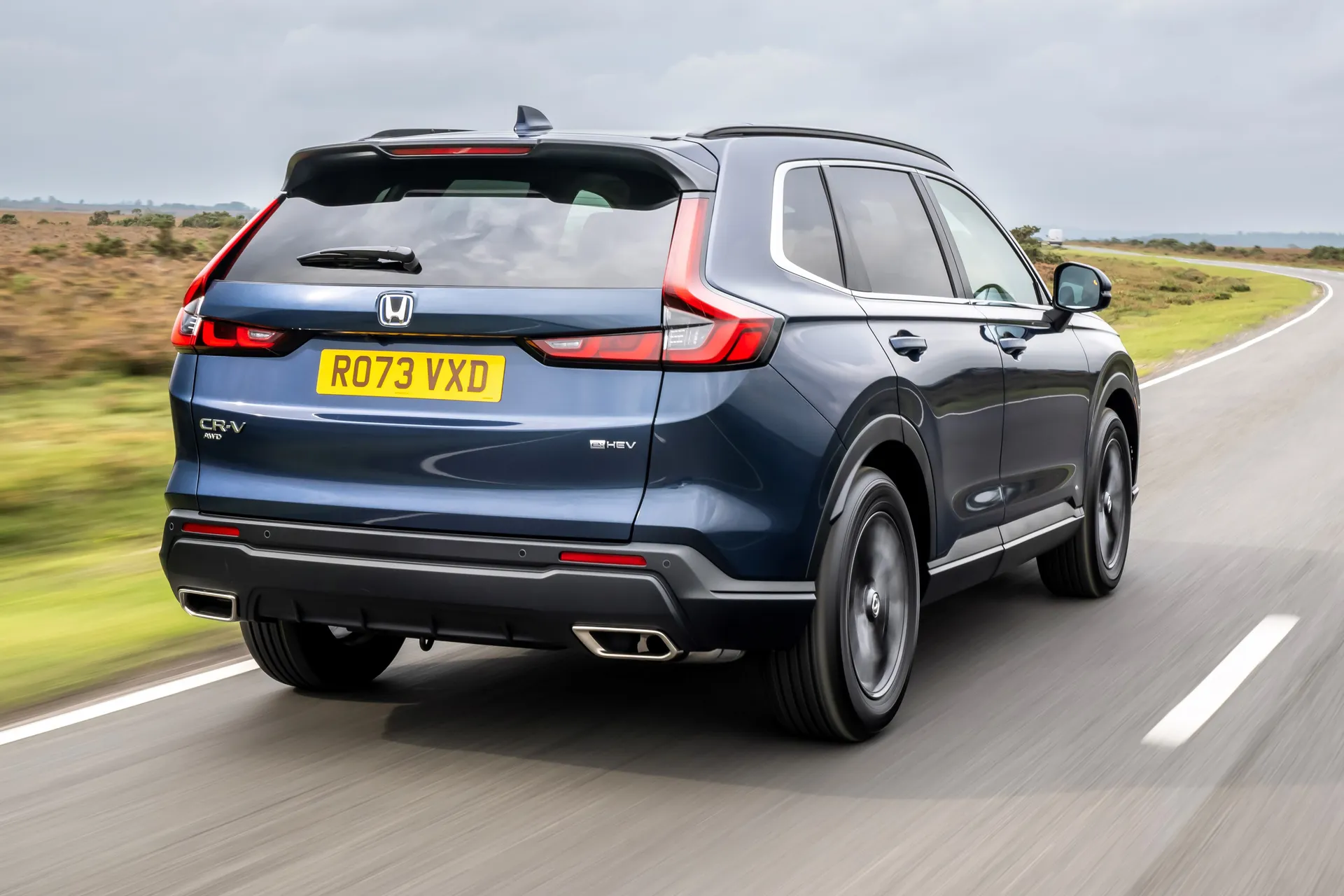
Honda first started producing the original CR-V in 1995, and has spent the decades since refining and improving its family SUV.
This latest sixth-generation model, introduced in 2023, borrows heavily from the current Honda Civic, which supplies its interior design and hybrid technology. All of this is a major positive, however, as the latest Civic is one of the best hatchbacks on sale.
For the Honda CR-V, buyers have the choice of the e:HEV regular hybrid or the e:PHEV plug-in hybrid version. Both come with the same 2.0-litre petrol engine, typically used as a generator to power the electric motors, rather than driving the wheels directly, although it does help with that occasionally.
The e:PHEV is likely to appeal to company car drivers, being able to cover up to 50 miles on battery power alone. Even the regular e:HEV can average more than 42mpg in official tests, and can largely replicate this figure in the real world.
Compared to rivals like the Toyota RAV4 and Hyundai Tucson, the Honda CR-V looks expensive to purchase new. Honda does offer a generous level of standard equipment, though, every model coming with leather upholstery, satellite navigation and a panoramic sunroof. This is all housed within a large cabin that is even more spacious than its CR-V predecessors.
It all makes for a SUV that meets all the practical requirements of family life. The Honda CR-V is affordable to run and delivers a comfortable and refined driving experience.
Aside from its high list price, which is partially offset by the plentiful amount of standard technology, we can find very little to fault with the sixth-generation Honda CR-V.
Looking for a used car for sale? We've got 100s of Honda Approved Used Cars for Sale for you to choose from, including a wide range of Honda CR-V cars for sale. If you're looking for the older version, you need our used Honda CR-V (2018-2023) review.
Is the Honda CR-V right for you?
Honda has refined the CR-V formula to create an efficient and practical family SUV, with the promise of an easy ownership experience included. If you want a car that will be affordable to run, offers plenty of space and is packed with technology, the Honda CR-V should be on your shortlist.
The only potential downsides are that performance is nothing to write home about, plus list prices that look quite expensive. Finding a used example negates the latter issue, though, and who really needs a rapid family SUV?
What’s the best Honda CR-V model/engine to choose?
Choosing the best version of the Honda CR-V for you depends upon whether you have the option to charge an electrified vehicle at home.
If you can install a domestic wallbox charger then the Honda CR-V e:PHEV plug-in hybrid makes the most sense. This will allow you to take advantage of up to 50 miles of battery range before the petrol engine cuts in, and the accompanying low running costs.
The e:PHEV comes in only one trim level, with a generous amount of standard equipment, too.
If you cannot charge at home, the regular hybrid Honda CR-V e:HEV is certainly not a bad compromise. Although it cannot offer the same lengthy electric-only range, it will still be economical to run.
Of the two trim levels offered for the e:HEV, the entry-level Elegance model features ample equipment for most buyers.
What other cars are similar to the Honda CR-V?
There is no shortage of options when it comes to family SUVs, meaning the Honda CR-V has plenty of competition. Looking at rivals for the plug-in hybrid e:PHEV model, the CR-V is similar to the Toyota RAV4, Mazda CX-60, Lexus NX and BMW X3 (due to its premium pricing).
Competitors up against the regular hybrid Honda CR-V e:HEV include the Kia Sportage, Hyundai Tucson and the self-charging version of the Toyota RAV4. There is Honda’s own smaller ZR-V hybrid to consider as well.
Comfort and design: Honda CR-V interior
“Borrowing an interior design first seen in the Honda Civic, the sixth-generation CR-V is modern and minimalist inside, and comes with comfortable and supportive seats.”
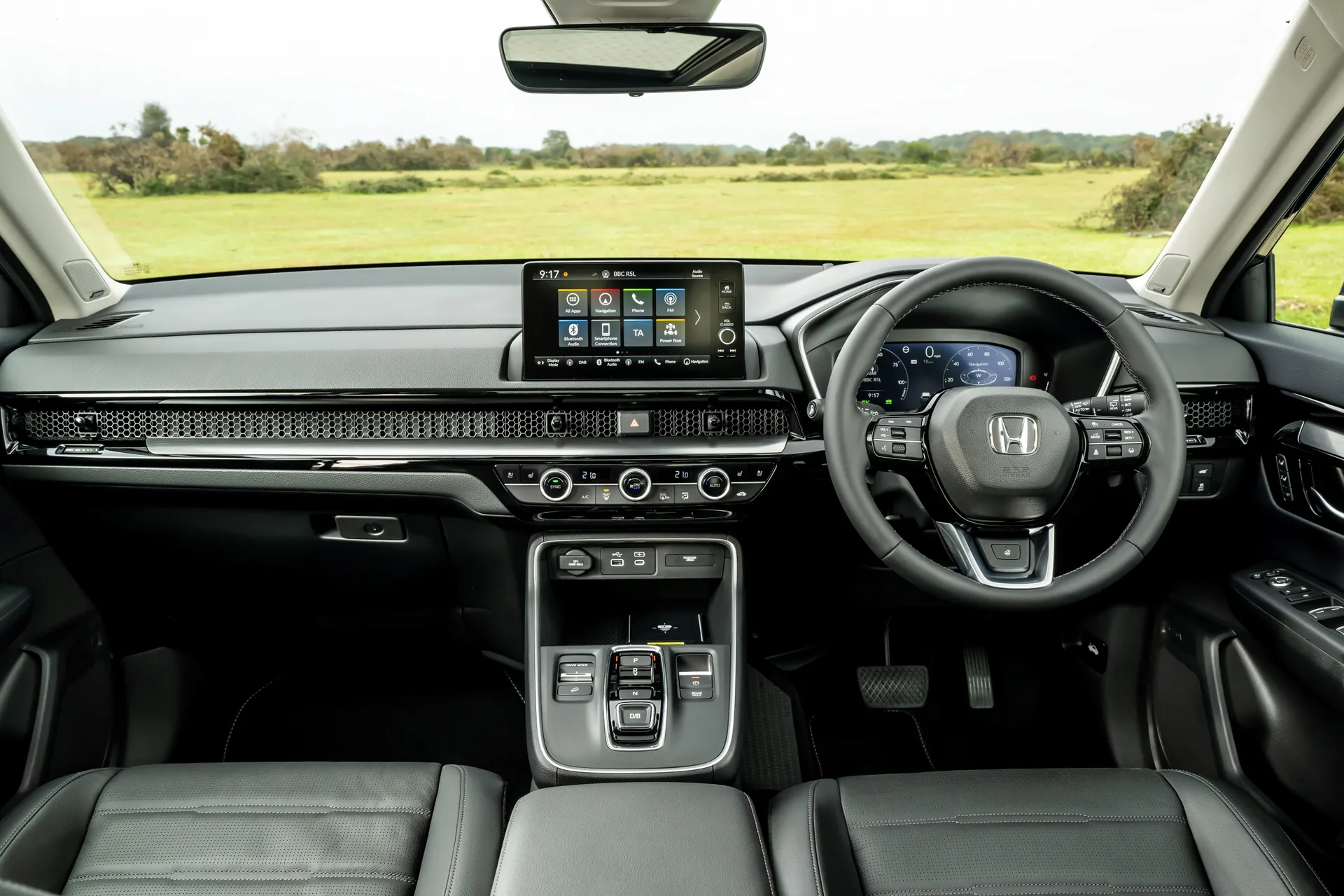
The current Civic hatchback has been used as a template for a host of modern Honda models, with the latest CR-V included among them. Honda has clearly sensed it is onto a winner with this layout, blending a minimalist design with an overall sense of logic and usability.
Physical buttons and dials are used throughout the cabin, but without it feeling cluttered or overwhelming. This avoids the issue found in many of the CR-V’s rivals, where performing even the simplest of tasks requires navigating multiple menus in a touchscreen media system.
A high seating position aids the already impressive level of visibility, and gives the driver a commanding feel behind the wheel. Eight-way electrically adjustable seats are fitted as standard, while all but the Elegance model come with a helpful memory function.
Such a high level of adjustment means it should not be a problem getting comfortable, even if the seats can initially feel rather firm. This does mean they will be more supportive on longer journeys, however.
Quality and finish
The overall level of finish inside the Honda CR-V is robust, meaning it feels like it should survive whatever family life can throw at it. It’s sensible and logical, rather than over-styled and chintzy.
All of the switchgear is well dampened and solid, and there are enough soft-touch materials where needed to give an upmarket vibe. There is a lot of gloss black plastic, and some of the trim found lower down can feel a bit scratchy, but this is arguably the same in most modern SUVs.
Every model in the CR-V range comes fitted with black leather upholstery as standard, along with a heated, leather-wrapped steering wheel.
Infotainment: Touchscreen, USB, nav and stereo in the Honda CR-V
With a similar interior layout to the latest Honda Civic, it should come as no surprise that the new CR-V shares the same infotainment setup as the smaller hatchback.
This is a positive move, with the CR-V’s 9.0-inch Honda Connect infotainment touchscreen being clear and simple to use. Although the graphics may seem a little dated, the screen reacts quickly to inputs and is logical to use. Aiding this is a set of physical shortcut buttons, including a proper volume knob.
There are also physical buttons and knobs for the climate control air-con, meaning there is no delving into touchscreens just to change the temperature.
Honda fits a digital instrument panel as standard to all CR-V models. As with the infotainment screen, it is easy to use, if a little lacking in visual flair.
All versions of the CR-V come with a DAB radio, Apple CarPlay and Android Auto connectivity, plus wireless smartphone charging and satellite navigation as standard.
An eight-speaker audio system is fitted to the CR-V Elegance, but the Advance and Advance Tech models come with a 12-speaker Bose Premium setup instead.
Space and practicality: Honda CR-V boot space
Compared to its predecessor, the latest Honda CR-V has grown in length by a substantial 106mm. This makes it 4706mm long, with a width of 1866mm, placing it at the larger end of the family SUV spectrum.
That extra length includes a longer wheelbase, with the promise of extra space for passengers. Curiously, Honda has resisted the urge to add a third row of seats to the CR-V, meaning it remains a five-seat-only option.
Room in the front of the CR-V is generous, with lots of legroom and a generous amount of headroom. There is a panoramic sunroof fitted as standard, but even this avoids being a problem for the tallest drivers, unlike in some rival SUVs.
In the rear, the CR-V is wide enough to accommodate three adults across the bench seat. There is a slight hump in the floor that the person in the middle will have to straddle, but otherwise headroom and legroom should be more than sufficient. The rear seats have multiple angles of backrest reclining to select from, too.
Curiously, when it comes to boot space, the plug-in hybrid e:PHEV version of the CR-V actually has a greater cargo capacity. With the rear seats up, it can accommodate 635 litres of luggage, increasing to a potential 1728 litres with the back seats folded down.
In the e:HEV hybrid, the CR-V offers 596 litres of luggage space, or 1651 litres when the rear seats are dropped. This includes some useful underfloor storage, in addition to the multiple cubbies found throughout the cabin.
Handling and ride quality: What is the Honda CR-V like to drive?
“Honda has made the CR-V a fuss-free way to cover ground. It handles and rides capably, and the e:PHEV models gain adaptive dampers.”
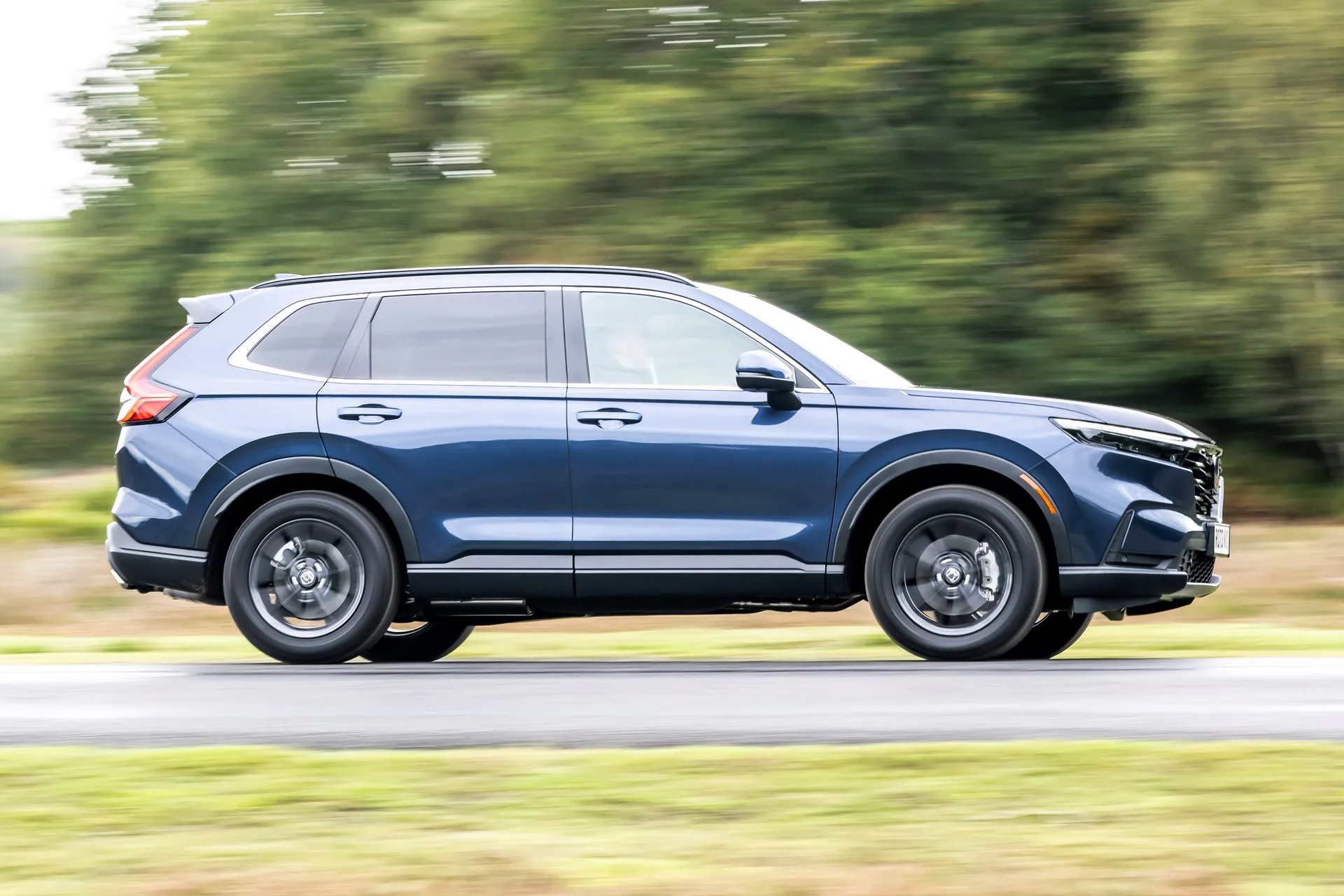
Honda may produce the Civic Type R, arguably one of the most engaging hot hatchbacks around, but it has wisely resisted all temptation to distil that hardcore driving experience into the CR-V. This is a hybrid-powered family SUV, after all.
That isn’t to say the Honda CR-V does not handle competently, though. Its steering setup is well weighted, with a direct response, and it feels more agile than some of its closest rivals. That said, there is more body-lean than there is in SUV rivals with a more sporting bent, and the extra weight of the larger battery in the e:PHEV can blunt its reactions a touch further. Ultimately, this will lead to a more relaxed driving approach, which is no bad thing, and it suits the CR-V’s easygoing nature.
At low speed the ride can be a touch firm, but again the CR-V feels more compliant than many other SUVs. Once up to speed, the firmness fades away, allowing bumps and ruts in the road to be soaked up effectively. The regular e:HEV uses reactive suspension dampers, while the heavier e:PHEV plug-in hybrid comes equipped with adaptive dampers.
The latter allow for a choice of settings to vary the firmness of the suspension, leading to a particularly comfortable driving experience.
What engines and gearboxes are available in the Honda CR-V?
The Honda CR-V is offered with two hybrid powertrains: the e:HEV is a self-charging hybrid, while as the name suggests, the e:PHEV is a plug-in hybrid.
Both feature a 2.0-litre petrol engine, which produces 148PS alone, and also acts as a generator for the electric motors. This results in a total power output of 184PS, which is lower than some of the CR-V’s main rivals.
In the Honda CR-V e:HEV hybrid, power is sent to all four wheels, offering the potential for a 0-62mph time of 9.4 seconds. This does not tell the full story, though, as the instant torque from the electric motors makes the CR-V feel quicker on the road.
Although the plug-in hybrid CR-V e:PHEV uses a similar powertrain - but with a larger 17.7kWh battery giving an electric-only driving range of 50 miles - it only sends its power to the front wheels. This has little impact on performance, with the same 0-62mph time quoted as for the regular hybrid model.
The e:PHEV also comes with a dedicated towing mode, which helps balance battery power when pulling heavy loads. This allows the plug-in hybrid CR-V to tow trailers weighing up to 1500kg.
Refinement and noise levels
Honda’s hybrid system is designed to enable the use of battery power alone at lower speeds. This means that, when driving around town, the CR-V can be very quiet and refined.
Unlike some other hybrid-powered SUVs, the design of the hybrid setup avoids the issues often seen with CVT automatic gearboxes. The car doesn’t cling onto engine revs to build power, keeping noise levels down.
Wind- and road noise are well contained as well, making the CR-V a refined travelling companion on longer journeys.
Safety equipment: How safe is the Honda CR-V?
The list of standard safety equipment is extensive, thanks to Honda’s Sensing 360 package. Along with a host of airbags (11, to be exact), there is also collision mitigation braking, lane-change collision mitigation, active lane-change assist, and lane-keeping assist. You even get cornering speed assistance, which works with the adaptive cruise control system. This can detect bends in the road ahead, then reduce the car’s speed automatically to ensure safe progress.
That Honda Sensing 360 stuff is that the reason that the car scored the full five-star rating in Euro NCAP crash tests. It only scored four stars when tested without it, a form in which its offered in other international markets, but the package comes as standard on all UK-spec CR-Vs.
MPG and fuel costs: What does a Honda CR-V cost to run?
“The plug-in hybrid version of the new CR-V can, according to official figures, achieve 353mpg, and cover up to 50 miles on battery power alone. The regular hybrid CR-V delivers almost 43mpg.”
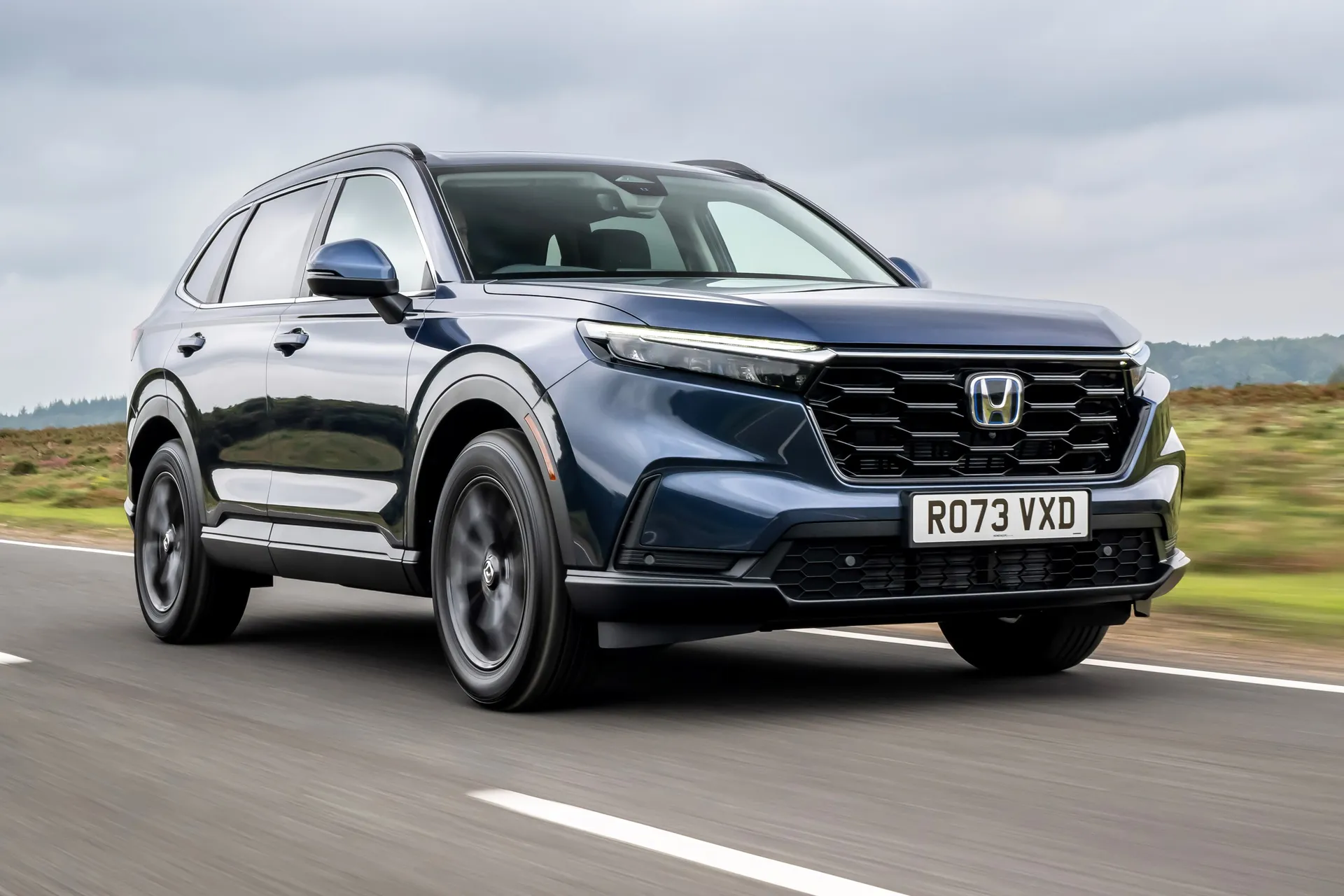
As with all official fuel economy figures, take the plug-in hybrid Honda CR-V’s headline numbers with a pinch of salt. Achieving the quoted 353mpg would require keeping the batteries constantly topped up, and doing short enough journeys that the petrol engine is hardly ever called into action.
Charging the CR-V e:PHEV’s battery pack should take just 2.5 hours using a 7kW home wallbox, meaning you can make the most of the potential to cover 50 miles on electricity only.
Once the batteries in the e:PHEV are fully depleted, expect a real-world fuel economy figure of more like 40-45mpg.
For the hybrid Honda CR-V e:HEV, the official figure of 42.8mpg is one that can be easily replicated on the road. Journeys with more stop-start traffic, which plays to the hybrid’s strength, will see relatively greater efficiency.
Honda CR-V reliability and warranty
Honda has a formidable reputation for quality and reliability, meaning the all-new CR-V is unlikely to cause many concerns. In the most recent 2025 Honest John Satisfaction Index, Honda was ranked in fourth place (out of 33 car brands) for reliability, ahead of Kia and Mazda.
The CR-V itself, meanwhile, was ranked as the 7th most reliable model in the entire study, although this latest sixth-generation model won't have contributed much to that.
New Honda cars come with a three-year or 90,000-mile warranty, although there are numerous offers around to extend this to five years instead. There is also a separate five-year or 90,000-mile coverage for the IMA hybrid system, too.
Honda CR-V insurance groups and costs
When it comes to insurance, being expensive and high-tech naturally means that the Honda CR-V will cost more to cover than a simpler supermini.
Both trim levels of the Honda CR-V e:HEV are placed in group 34 (out of 50 groups in total) for insurance. For comparison, a hybrid Toyota RAV4 starts in group 25 for the entry-level model.
Opting for the Honda CR-V e:PHEV sees the insurance ranking upped to group 37 instead. A plug-in hybrid version of a Mazda CX-60 can be found in group 38 or 39, meaning the Honda is likely to be a little cheaper.
VED car tax: What is the annual road tax on a Honda CR-V?
All versions of the Honda CR-V cost more than £40,000 when brand new, mean all are liable for the ‘luxury car’ surcharge on VED. This means that, on top of the normal £195-per-year flat rate, you'll also pay an additional £425 per year for a temporary five-year period between years two and six of the car's life. That applies whether you're buying new or used.
Honda CR-V price
“When bought brand new, prices for the Honda CR-V start at more than £47,000 for the entry-level Elegance version, meaning it's certainly not a cheap option compared with rivals. You'll pay more like £50,000 for both the Advance and the Advance Tech PHEV.”
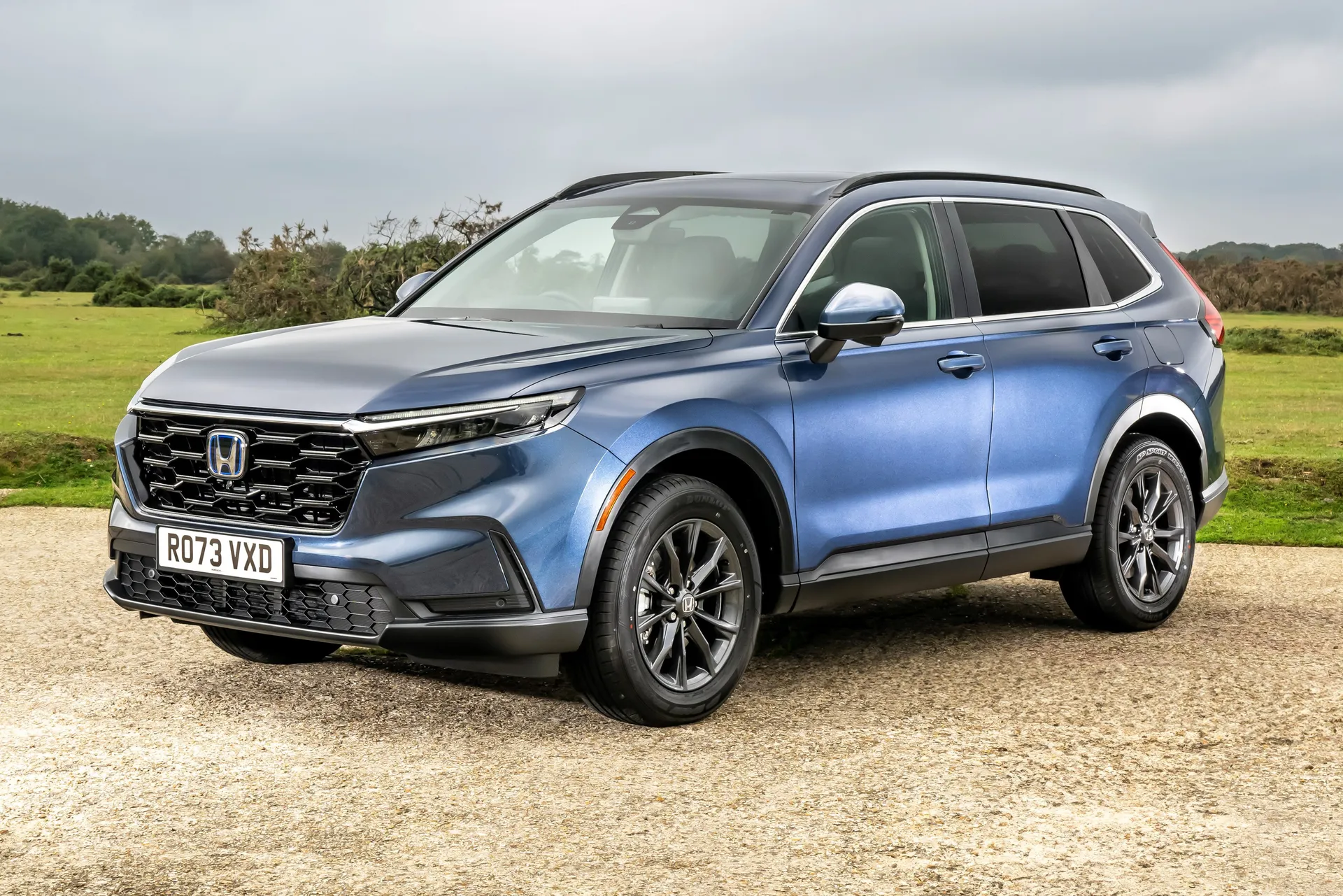
As ever, though, there are vast savings to be made on the used car market. Browse the heycar classifieds, and you'll find several sixth-generation CR-Vs hovering at about the £34,000 mark. These are mainly self-charging-hybrid examples from 2024 with around 15,000 miles in the dial, and for about the same money, you can have a PHEV that's a year older with slightly higher mileage.
Trim levels and standard equipment
The Honda CR-V comes with a choice of two trim levels for the regular e:HEV hybrid.
Elegance is the starting point for the CR-V e:HEV, with 18-inch Shark Grey alloy wheels, LED lights with automatic high-beam, privacy glass, roof rails and a panoramic sunroof.
There is also a rear-view camera, front- and rear parking sensors, a power-operated tailgate, dual-zone climate control and an interior finished in black leather. The front seats are heated, and come with eight-way electrical adjustment. Keyless entry and start are included, along with the Honda Sensing 360 suite of safety systems.
A 9.0-inch infotainment touchscreen is fitted, with DAB radio, Apple CarPlay and Android Auto connectivity, sat nav, and live traffic information. Honda includes a digital instrument display and wireless smartphone charging as well.
Moving up to the Honda CR-V e:HEV Advance brings extra equipment, including headlights with adaptive driving beam, a multi-view parking camera and a Bose premium sound system. Heated outer rear seats are included, with the leather-wrapped steering wheel also heated. The driver’s seat also comes with a memory function for the power adjustment.
The Honda CR-V plug-in hybrid e:PHEV is sold only in Advance Tech trim, acting as a range-topping model.
Standard equipment includes 18-inch alloy wheels in Berlina Black, an exclusive black front grille, body-coloured bumpers and wheelarches, and a panoramic glass sunroof. The door mirrors are black and there is a high-gloss black finish for the window surrounds.
Other standard equipment includes a multi-view camera with Honda’s Parking Pilot system, a dark-coloured headlining and a Bose sound system.
Ask the heycar experts: common questions
Is there an all-electric version of the Honda CR-V?
How long is the warranty on the Honda CR-V?
Is the Honda CR-V a good SUV to buy?
Get our latest advice, news and offers
Keep me updated by email with the latest advice, news and offers from heycar.
By submitting you agree to our privacy policy
